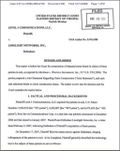Details From The Markman Ruling In Level 3 and Limelight Networks Patent Case

Over the weekend I got to read through the Markman order that was issued on December 10th in the Level 3 and Limelight Networks patent suit. While a Markman hearing typically does not bring a lot of surprises, there were some interesting details about the suit that came to light from the ruling.
The case was reassigned to a new Judge on September 17th of this year
and it is interesting, but not surprising, that the Judge was not
familiar with the technology being discussed. In fact, he even thanked
both parties saying that the materials they submitted and the technical
explanations provided "were all extremely helpful in
educating the Court about the nature of the technology at issue in this
case." While the lack of technical knowledge by the Judge probably surprises no one, you'd think the court would try to assign the case to someone that has some previous experience with what is being discussed.
Level 3 and Limelight were originally in dispute over twenty two terms but came to agreement on four terms (Subscriber, Resource, URL, Default Path) leaving the court to rule on eighteen terms. The rest of the claim constructions in dispute were in reference to Level 3's 807 and 935 patents, which combined have 66 claims and make for some long reading. So if you want the details on each patent, hit the links for the filings.
The eighteen terms in dispute were Origin Server, Repeater Server, Repeater Server Network, Name, Rejecting the Client Request, Client Request for a Resource, Appropriate Repeater Server, Repeater Selector Mechanism, Subscriber Verifying Mechanism, Embedded, Handled, Obtaining a Client Request, Determining, Alternative/Alternate Path, Destination, Overlay Node, Dynamic Router and Real-time Traffic Information.
For eleven of the terms, the Judge ruled in favor of Level 3's definition and for the other seven terms, the Judge used a combination of Level 3 and Limelight's definition and/or suggestions from the Court expert, Dr. Zegura, to create his own definition. The fact Limelight did not win any of the claims outright is really not surprising since typically the Plaintiff tries to assert very wide claims while the Defendant tries to narrow down the scope of the meaning. Some of Limelight's proposed definitions were too over reaching and some of Level 3's definitions were too broad and "technically correct but insufficiently descriptive."
There was one instance where Level 3 suggested to the Court that it should adopt its ruling on the definition of "Alternative/Alternate Path" because it was the agreed upon construction in the Cable & Wireless and Akamai suit. The Court didn't agree with the argument saying that "Akamai Technologies is a competitor of both Plaintiff and Defendant and a non-party to the instance case."
Overall, I think both sides got some of their definitions well established and while most would probably say that Level 3 did better, I don't think anyone truly knows if that is true until the case goes to court and we see what phrases and definitions are most important in the case. We can expect that to happen sometime next year.
Note: While I have worked as an expert on multiple patent suits, I have never worked on any patent suit involving any content delivery network.
